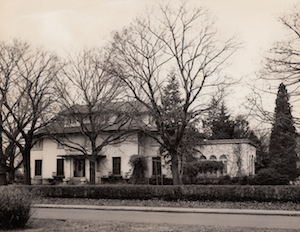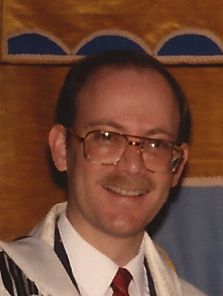 In 1953, seven families, united by energy, zeal and optimism, decided to establish a house of worship, study, and social gathering. Their dream was based on the conviction that Jewish life should have a place in the community of Garden City.
In 1953, seven families, united by energy, zeal and optimism, decided to establish a house of worship, study, and social gathering. Their dream was based on the conviction that Jewish life should have a place in the community of Garden City.
As word of the young group spread, other Jewish families joined with them and the young congregation grew to forty members. Because there was no permanent place to worship, initially Sabbath services were held in various members’ homes. In 1953, the Cathedral of the Incarnation offered its Cathedral House for the High Holy Days services, which were led by Rabbi Moritz Speier of the Mineola Synagogue. Then, with the assistance of Adelphi College’s president, Dr. Paul Dawson Eddy, permission was granted to use the Science Room in Blodgett Hall for Friday night services, and Adelphi’s Playhouse was made available for High Holy Day services. A religious school was initiated, too, which initially held classes in the Equitable Life Insurance Company’s Hempstead building until Dr. Eddy offered the use of Adelphi’s Hillel offices. Although grateful for these considerations, the families remained determined to acquire a place of their own. However, the task was to prove more arduous than they had anticipated. Not only would they have to overcome the usual difficulties of establishing a house of worship, but they would have to overcome local resistance to what would be Garden City’s sole synagogue.
One of the first problems faced was that of affiliation, which was complicated by the fact that membership came from divergent backgrounds of Jewish observance. This matter was to be settled by a vote: the Garden City Jewish Center would become part of the Reform movement of the Jewish faith, and we proceeded to join the Union of American Hebrew Congregation. In the beginning, Rabbi Daniel Davis was our liaison with the UAHC, recently renamed the URJ, and he further assisted us during our struggle to obtain a Certificate of Occupancy from the Village of Garden City. Then, on October 31, 1954, a constitution was adopted and officers were elected. This document would undergo a series of revisions, until the adoption of By-laws at the January, 2004, Congregation Meeting.
By 1955, we had a Youth Group and a Judaica shop. But, most significantly, on January 20, 1956, we purchased the property intended as the site for our temple. It was now that we faced our greatest challenge when the Board of Appeals of the Incorporated Village of Garden City denied our application to use the building as a synagogue. Assisted by our attorney, C. Walter Randall, we submitted an appeal to the New York State Supreme Court in Mineola. A decision by Supreme Court Justice Marcus Christ reversed the ruling of the Garden City Board of Appeals. A permit was finally granted for occupancy of a temple at 168 Nassau Boulevard. We had our home.
 What we had purchased was a private home. What we had to create was a house of worship. All went to work with hammers, paint brushes, dust cloths, buckets, and enthusiasm. The music room was transformed into our sanctuary by the joint efforts of not only our congregants but members of other community faiths as well, so that the Long Island Newsday printed a feature article about the new temple, titling it “A Symbol of Brotherhood.”
What we had purchased was a private home. What we had to create was a house of worship. All went to work with hammers, paint brushes, dust cloths, buckets, and enthusiasm. The music room was transformed into our sanctuary by the joint efforts of not only our congregants but members of other community faiths as well, so that the Long Island Newsday printed a feature article about the new temple, titling it “A Symbol of Brotherhood.”
On March 8, 1957, the first Sabbath was observed in our new temple building. Its formal dedication took place on December 11, 1957 with Rabbi Morris Rose officiating. He described the temple as a labor of love and devotion. The dedication was attended by George F. Whitlock, Mayor of Garden City; Reverend James DeWolfe, Episcopal Bishop of Long Island; Rabbi Daniel Davis, New York Director of the Federation of Reform Synagogues; and Rabbi Alvan Rubin of Temple Sinai, Roslyn. The main speaker, C. Walter Randall, Esq., our friend throughout the months of legal challenges, was described as “eloquent, stirring and optimistic.”
After several years of having members volunteer to serve as cantor, in 1959 we were gifted with our first ordained cantor: the devoted Gerald Manuta, who served for 27 years, until 1986, when we welcomed Joy Holzberg Parks as cantor. In 1961, we accepted another gift: a second Torah from the Eckstein family. And on our Tenth Anniversary, in 1963, the Tornbergs presented us with a third Torah. In September, 1962, the Congregation acquired the services of a dynamic young rabbi, Ralph Kingsley. During his tenure, we purchased the parsonage, and in 1965 built the extension, once named the Community Wing, but now known simply as the Social Hall.
Rabbi Kingsley worked to secure our synagogue’s place in Garden City and mature in its spiritual commitments. He was active in community affairs, taught evening classes at the Garden City High School and promoted adult education, among our members and non-members as well. The work begun by him was continued by Rabbi Meyer Miller and his wife, Shulamith, who came to us in 1970, having just returned to this country after serving in South Africa for twenty years. Many of the innovations begun by these two Rabbis have become traditions, though altered with time. Rabbi David Nelson, in the 1980’s, continued the tradition of an annual Open House, but set the festivities beneath the sukkah he would build each year in the parsonage’s backyard. Rabbi Nelson continued to conduct evening adult education courses, as well as Saturday Sabbath service and studies, and he a formed a Jewish Music class in which Joyce Brenin, Carolyn Hoera, Ann Lyons, Norma Mindell, and Joan Weitzner learned Yiddish, Hebrew and Middle Eastern songs. With Lenore Cassese chairing the School Board, Purim plays, once presented by our Shtetl Players in 1976, 1977, and 1978, were now being performed annually by our Hebrew School children; Purim Carnivals had now evolved into raucous celebrations; and Lag B’Omer Day sporting activities continued, but left the temple grounds for local parks to become our Annual School Picnic. Model Seders also became annual events, and opportunities to teach not only our children but also the youth of other denominations. Outreach programs continued, but came to include participation of our teenagers in the Lay Ecumenical Garden City Youth Fellowship, which sponsored annual charity drives and encouraged various Christian groups to attend temple services. As numbers dropped, a Pre-K program was instituted to stimulate membership growth. And on March 19, 1988, the congregation returned to the Island Inn to mark our “mortgage-burning” month with a party.
In 1985, we were again blessed when Rabbi Stephen Goodman came to lead our congregation.  Rabbi Stephen Goodman, as well as his wife Rabbi Linda Goodman, have continued our temple’s outreach work: taking our youth to Washington for a march supporting Soviet Jewry, initiating contributions to the Interfaith Nutrition Network, and participating in inter-faith clergy forums, services and activities in the Garden City community. In addition, our Rabbis are active members of the boards of CCAR, the New York Board of Rabbis and the Nassau Chapter of the New York Civil Liberties Union. In 1988, Carolyn Hoera became School Board Chair, and worked with Rabbi Goodman to restructure the school, returning to Sundays-only and compartmentalized grouping, as well as bringing the school to the twenty-first century with a computerized language lab to supplement the curriculum. Whereas once we took turns serving dinners to new congregant families before returning to temple for dessert and home-grown talent shows, which starred Joyce Brenin singing “My Yiddisha Mamma” and Stanley Lyons playing “Flight of the Bumble Bee”, Family Dinner/Services were now introduced, including the popular Annual Chanukah Latke/Dessert Party and a Tu Bi’Shvat Seder. Simchat Torah, once celebrated with dancing in the rear of the sanctuary, would now become a Social Hall Party. And pizza, shaped like Haman’s pocket, would now be served each Purim. Mitzvah Days, trips to the Jewish Museum, and hosting such programs as the shofar-makers all contribute to the on-going life of our temple.
Rabbi Stephen Goodman, as well as his wife Rabbi Linda Goodman, have continued our temple’s outreach work: taking our youth to Washington for a march supporting Soviet Jewry, initiating contributions to the Interfaith Nutrition Network, and participating in inter-faith clergy forums, services and activities in the Garden City community. In addition, our Rabbis are active members of the boards of CCAR, the New York Board of Rabbis and the Nassau Chapter of the New York Civil Liberties Union. In 1988, Carolyn Hoera became School Board Chair, and worked with Rabbi Goodman to restructure the school, returning to Sundays-only and compartmentalized grouping, as well as bringing the school to the twenty-first century with a computerized language lab to supplement the curriculum. Whereas once we took turns serving dinners to new congregant families before returning to temple for dessert and home-grown talent shows, which starred Joyce Brenin singing “My Yiddisha Mamma” and Stanley Lyons playing “Flight of the Bumble Bee”, Family Dinner/Services were now introduced, including the popular Annual Chanukah Latke/Dessert Party and a Tu Bi’Shvat Seder. Simchat Torah, once celebrated with dancing in the rear of the sanctuary, would now become a Social Hall Party. And pizza, shaped like Haman’s pocket, would now be served each Purim. Mitzvah Days, trips to the Jewish Museum, and hosting such programs as the shofar-makers all contribute to the on-going life of our temple.
Furnishing the Garden City Jewish Center has also been an on-going tradition, dating back to 1957, when a group of men traveled into Kew Gardens to transport our pews purchased from an old reform temple undergoing renovation. Then in 1965, Charlie Grossman donated and drove his truck to the Manual Training High School (today’s John Jay HS) where he, Ralph Tornberg, Julie Kendall, and Artie Kreisberg lugged all the laboratory tables down 6 flights and transported them to our Social Hall, where they’ve remained ever since. Barry Brenin created a sukkah that could be dismantled and re-erected, as it has been for the past 25 years. And the tradition of members working to renovate our temple continues today: Jeff Krupen saw to the roof being repaired as well as the Social Hall’s floor and ceiling being refinished, Jessica Epner helped have new bathrooms installed, Lenore Cassese had the Social Hall refurbished, Elaine Kreisberg and Carol Sussman gave a lift to the Hall with new window treatments, Cindy Mevorach transformed the storage room into a classroom, and Danni Werner expanded and put a new face on our Judaica Shop display. But throughout the 1990’s and into the 21st Century, it has been Peter Tittler, Jay Minsky, and Ben Carreras who have tirelessly helped with countless repairs and improvements.
In addition to contributing labor, our congregants, their friends and family, have been generous in the offerings they’ve donated: The Landau family, though not members, presented us with our first Torah. The Samuels family donated funds towards purchasing a central air-conditioning system in memory of Mel Samuels. And the Robins family commissioned an artist to construct the sanctuary’s stained glass windows as a memoriam to “Doc” and Matilda Robins. Confirmation classes, too, have expressed appreciation by donating articles ranging from silver candlesticks to a silver punch bowl, from an electronic keyboard to a tzedakah box. On the occasion of the 50th wedding anniversary of Arthur and Elaine Kreisberg in May 2001, their children, Jan and Charlie Rosenberg, and Billy Kreisberg, donated a brand new eternal light which hangs over our ark to commemorate this event. Talented members and friends have made their offerings, too: Fred Korn constructed our Ark, and Burt Weitzner carved onto it the Ten Commandments as well as the shofars on our pews and bima. Dora Gaba compiled a cookbook which served as a fundraiser for many years. Barry Brenin designed and sculpted the candelabra which he presented to the temple in honor of the 55th anniversary of K. Karl and Gladys Klein as well as the sculpture in the hallway leading to the sanctuary in memory of his first wife, Joyce. The estate of the late Reverend Karl Baer, who with his wife Anna Ruth supported us during our early efforts to establish ourselves in Garden City, recently gifted us with several of his sculptures, displayed both in our sanctuary and art room, as well as at our parsonage.
In the journal commemorating our 25th anniversary, it was written, “A true measure of the success of an organization is to compare its original aspirations with its achievements.” The conclusion was then, and continues to be now, that “We have done well!” It was written then:
We have been fortunate in our religious and lay leaders. We have survived as a congregation despite our small numbers. We have been an extended family to one another, sharing joys and sorrows. We have become a part of this lovely community; a neighbor and friend in the communal and spiritual life of the Village. We have given support to the needs of Jews everywhere. Our record speaks well of our concern for the Land of Israel. But above all else we are a House of Worship, a place of learning and a center of Jewishness. As such we are a refuge of stability and wisdom among the constantly shifting and churning value systems of twentieth century America….Let us pray we may laud the Garden City Jewish Center with gratitude and rejoicing on its GOLDEN JUBILEE.
It would seem that our prayers have been answered.
Lenore Cassese
<—————————————>
During the past 20 years, we’ve seen many families, singles, and members of all ages enjoy attending the High Holiday services, celebrating Sukkot in the sukkah, dancing with the Torah in the Sanctuary on Simchat Torah, the Chanukah latke and dessert party and service, the Purim pizza party, service and carnival, Model Seders, and many more events.
We’ve installed equipment and software to support “multi-access” events (both in-person and via Zoom). We’ve used this technology to broadcast High Holiday services, Bar/Bat Mitzvahs, baby namings, etc. around the world.
During the COVID epidemic, we switched to Zoom only services for a period of time but we are now back in person for services, Religious School and associated events.
We’ve made it through first 65 years and are looking forward to the next 65.

